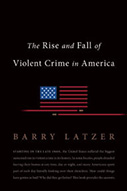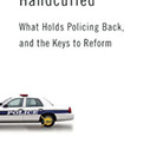The Rise and Fall of Violent Crime in America

Author: Barry Latzer
Publisher: New York: Encounter Books, 2016. 424p.
Reviewer: Sam Bieler | September 2016
From the abortion hypothesis to theories about leaded gasoline, understanding the rise and fall of violent crime in America is one of criminologists’ most popular pastimes. Frequently however, these explanations follow a similar trajectory: they begin in the 1960s or early 1970s with the dramatic rise in violence, then offer a key change or set of changes that drove a near uniform downward decline in the 1990s. All of this packed into a mere 20 to 30 years with little if any mention of America’s preceding 200 years of social and economic development. For those who think that the artificial universe created by this partition must elide some important details, Professor Barry Latzer’s The Rise and Fall of Violent Crime in America is a welcome arrival, and an invaluable contribution to the study of violent crime in America.
The core argument of The Rise and Fall of Violent Crime is that a subculture of violence in Black communities plays an underappreciated role in understanding America’s violent crime trends. While Latzer is not the first criminologist to explore violent subcultures, he is certainly among the first to suggest that this subculture plays an important role in driving both the dramatic rise in violent crime in the 1960s and 70s and its subsequent precipitous fall.
It would be an understatement to say that such an argument is a controversial one, and perhaps in awareness of this, the book marshals a truly impressive array of historical and social scientific information, beginning its argument not in the 1960s or 1970s, but in aftermath of WWII — with supporting arguments stretching back to the 18th century. The book extends the window of analysis this far to explore the origins of violence in the United States, when violence was a phenomenon concentrated in rural Southern communities rather than Northern urban ones. Latzer suggests that a culture of Southern violence was created due to a wide array of factors. In particular, he notes that the preexisting culture of particular Scottish and English communities that immigrated to the South, as well as the comparative lawlessness of the region (p. 216) may have played an important role in creating a subculture where violence was more acceptable. White Southerners initiated this culture and forcibly inducted Southern Black communities into it. The Black communities subsequently faced systemic political and economic oppression from the 1890s onward that further nurtured this subculture of violence (p. 272).
But for the Great Migration and the Baby Boom, the rise in violence might have remained a Southern phenomenon. In Latzer’s telling however, these two trends combined to have a powerful impact on violence more generally in the United States. The Great Migration of black communities to Northern cities exported the Southern culture of violence into the North while the Baby Boom created a large youth population. Youth are already more likely to participate in violence, and the violent Southern subculture exacerbated these tendencies, particularly among Black youth (p. 152). Worse, the justice system of the 1960s proved wholly incapable of responding to this tumult, with police and courts unable to effectively apprehend or convict those engaged in this violence. This weakness, combined with the increasing youth violence, became a self-reinforcing cycle, with the violence reaching the type of “tipping point” described by Malcom Gladwell in which youth imitated each other’s violent behavior (p. 159).
All these factors seemingly went into reverse during the precipitous drop in violence in the 1990s. The justice system began responding to offending with an increasingly heavy hand, both through more aggressive policing and longer sentencing for those convicted. Simultaneously, the Baby Boom generation that drove so much of the great spike in violence began aging out of crime (p. 256). Finally, the contagion effect that had driven violence began to go in the other direction, as youth, witnessing firsthand the destruction wreaked by the crack boom of the late 1980s and early 1990s, began leaving the crack subculture and encouraging peers to do the same (p. 249).
Cultural assessments of violence have a dangerous habit of falling into a kind of circular logic, attaching the label of “violent culture” to any place where violence is found. Taking the historical perspective allows Latzer to avoid this trap. Tracing the heritage of the Southern culture of violence and its migration with Black and White Southerners, both from rural areas to cities and then South to North, lets Latzer show how violence follows a culture, rather than forcing him to apply the label of culture to areas where there just happens to be violence.
Through this argument, The Rise and Fall of Violent Crime marches into the breach created by holes in other popular theories for the rise and fall of violent crime — like the abortion hypothesis and the leaded gasoline theory. His argument seems even more compelling alongside accumulating evidence that some of the most effective tools for preventing violence are programs focused on changing the dynamics of violent crime, such as the National Network for Safe Communities and Cure Violence. Programs like these use both official deterrence by targeting people engaged in serious violence, and the moral authority of the community, to demonstrate that violence is unacceptable. If the cause, as Latzer diagnoses it, is a subculture that accepts and, in some cases, requires violence as a tool for self-preservation and respect, it follows that such programs are going to be the most effective cures.
Latzer also does criminology a valuable service by questioning the role of socioeconomic deprivation in violence. Poverty is often too readily tossed out as a catch-all explanation for violence, but Latzer pushes hard against this easy answer, noting that both in the 1960s riots (p. 125) and in violent crime generally (p. 165) poverty is at best a weak predictor of violence. Poverty plays a role in driving violence, but it does so indirectly through its influence on social and cultural mores. History thus provides the tool for understanding how poverty exerts this influence, and in doing so, offers a way to reconcile the views of those of who argue that culture plays the dominant role in explaining violence, and those who argue that structural deprivation does.
While the book effectively covers the historical perspective, however, its one blind spot may be found in its handling of more recent history, and in particular the recent role of the criminal justice system in supporting a culture of violence. In the past year, both David Kennedy, the researcher behind some of the country’s most innovative violence prevention programs, and Jill Leovy, the author ofGhettoside, have argued that the reenergized justice system born in the 1980s and 90s paradoxically over and under-policed Black communities, targeting them heavily for minor offenses while devoting little time or energy to investigating serious offenses. In this telling, it is this neglect by the justice system that contributes to a culture of violence: a lack of official attention signals that deaths in these communities are unimportant and tacitly accepted. In the face of official disregard, residents of these neighborhoods turn to violence to obtain justice. In this, one sees echoes of the lack of government attention and the willingness to use violence that helped create the honor culture of the South in the first place.
In The Rise and Fall of Violent Crime, the justice system of the 1980s and 90s that Kennedy and Leovy critique receives largely approving coverage. Latzer focuses primarily on the beneficial impact this aggressive system had on crime and gives little attention to the role such a dramatic restructuring of the system might have played in shaping the modern subculture of violence. Every book on the crime drop does not need to re-litigate the costs and benefits of mass incarceration and broken windows policing, but as more and more authors have begun assessing the cultural impact of these trends, it would have been interesting to explore these topics in the context of the impressive cultural history The Rise and Fall of Violent Crime already builds.
This is, however, a minor note in a masterfully researched and written work that capably demonstrates the importance of history in the study of crime. Professor Latzer is to be commended for developing an exhaustively researched yet eminently readable account that should be mandatory reading for any scholar of crime and violence in the United States.


